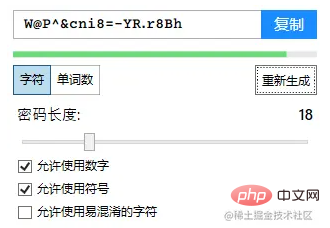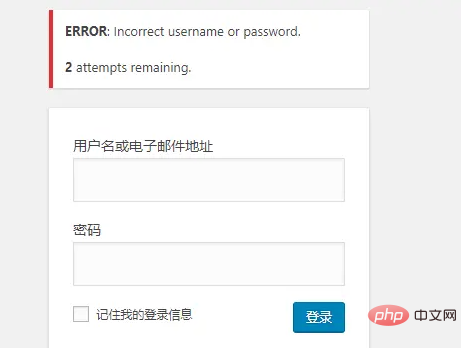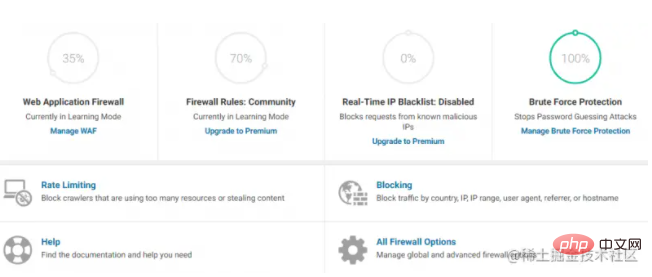 CMS Tutorial
CMS Tutorial
 WordPress
WordPress
 These tips can help you improve the security of your WordPress website! (recommend)
These tips can help you improve the security of your WordPress website! (recommend)
These tips can help you improve the security of your WordPress website! (recommend)
The following tutorial column of WordPress will introduce you to some methods and techniques to improve the security of WordPress website. I hope it will be helpful to friends in need!
Some methods and techniques to improve the security of WordPress website
If you want a stable WordPress site, in addition to ensuring that the website performance is sufficient, you must also pay attention to the website Security, by 2019 WordPress has supported one-third of the world’s websites, and various hackers are attacking WordPress more frequently. So how can we ensure that our WordPress site is secure enough? In this article, we introduce some WordPress security protection tips to make your website more secure.
A strong administrator password
When they first set up a WordPress site, many novices may not care about security issues and just set a password casually, such as admin , 123456, website domain name and other passwords, this is very inappropriate. Once someone else discovers such a weak password website, hackers can enter your website as easily as logging in to their own website.

So be sure to set a strong administrator password. For example, you can set uppercase and lowercase letters plus numbers, a password of more than sixteen digits, etc. If you are afraid of not remembering it, you can The password is saved in a safe place and you can reset your WordPress password even if you forget it.
Limit the number of logins
After setting a complex password, it only adds a layer of login protection. Hackers can still log in to the website by constantly trying different passwords. If by chance, If the password you set is in the dictionary, he can log in to the website.
So we need to limit the number of WordPress user logins to prevent violent poaching. For example, after logging in to the same client 10 times, the corresponding IP will be blocked.
General WordPress security plug-ins have login protection functions, or you can install a small plug-in like Limit Login Attempts Reloaded to specifically limit logins.

Change login address
WordPress has many reasons for password poaching attacks, the most important one is that of all WordPress sites The background login address is /wp-login.php, but if you change the default login URL, many attacks can be avoided.
WordPress changes the background login address plug-in WPS Hide Login
Keep the latest version of WordPress
This not only refers to updating WordPress to the latest version, but also Including WordPress themes, plug-ins, etc., must be kept updated.
We often hear that WordPress or some well-known plug-ins have vulnerabilities, but in fact many of them are old versions. Most development teams usually fix the vulnerabilities immediately after discovering them. This is why we need to keep them up to date. Because of the version, especially when encountering an upgrade that contains bug fixes, you must update.
If you don’t have much time to manage your WordPress site, it is recommended that you set up WordPress automatic updates so that WordPress will automatically update in the background without you having to manage it.
Do not install theme plug-ins from unknown sources
Some advanced themes and plug-ins in WordPress require payment to use, but some people go to unknown third-party websites in order to save money. Download the installation package from unknown sources and install it on your own website.
The WP theme site here strongly discourages this approach. First, there is no after-sales service and upgrades. Second, security is not guaranteed. If the website is attacked because of a small gain, it will be more than worth the loss.
Website Firewall
Website firewall is mainly used to prevent some common malicious attacks, such as malicious requests, XSS, SQL injection and other hacker attacks.
The plug-in recommended here is WordFence. WordFence has more than 3 million active installations, and the free version is powerful enough to defend against most network attacks.

In addition, if you are using Pagoda Professional Edition, you can also use its Nginx firewall to prevent attacks from the server. It is more convenient to operate on the panel and more powerful. .

Back up your site regularly
Last but not least, back up your WordPress site regularly.
Why should you back up your WordPress site? To prevent unknown errors on the website due to mistakes or attacks, there are ways to save them.
WordPress website backup can also be divided into many situations, such as manual backup, automatic backup, backup to cloud service, backup to local. It is recommended that you save several versions of backup locally and on the server to prevent unexpected incidents. In this case, you can check out this tutorial on how to back up WordPress.
If you can do the above points, your WordPress will be very difficult to be attacked. In fact, if there are no third-party plug-ins, WordPress itself is still very safe. As long as you make a backup, you don’t have to worry at all during normal use.
The above is the detailed content of These tips can help you improve the security of your WordPress website! (recommend). For more information, please follow other related articles on the PHP Chinese website!

Hot AI Tools

Undresser.AI Undress
AI-powered app for creating realistic nude photos

AI Clothes Remover
Online AI tool for removing clothes from photos.

Undress AI Tool
Undress images for free

Clothoff.io
AI clothes remover

Video Face Swap
Swap faces in any video effortlessly with our completely free AI face swap tool!

Hot Article

Hot Tools

Notepad++7.3.1
Easy-to-use and free code editor

SublimeText3 Chinese version
Chinese version, very easy to use

Zend Studio 13.0.1
Powerful PHP integrated development environment

Dreamweaver CS6
Visual web development tools

SublimeText3 Mac version
God-level code editing software (SublimeText3)

Hot Topics
 1669
1669
 14
14
 1428
1428
 52
52
 1329
1329
 25
25
 1273
1273
 29
29
 1256
1256
 24
24
 How to adjust the wordpress article list
Apr 20, 2025 am 10:48 AM
How to adjust the wordpress article list
Apr 20, 2025 am 10:48 AM
There are four ways to adjust the WordPress article list: use theme options, use plugins (such as Post Types Order, WP Post List, Boxy Stuff), use code (add settings in the functions.php file), or modify the WordPress database directly.
 How to build a website for wordpress host
Apr 20, 2025 am 11:12 AM
How to build a website for wordpress host
Apr 20, 2025 am 11:12 AM
To build a website using WordPress hosting, you need to: select a reliable hosting provider. Buy a domain name. Set up a WordPress hosting account. Select a topic. Add pages and articles. Install the plug-in. Customize your website. Publish your website.
 How to import the source code of wordpress
Apr 20, 2025 am 11:24 AM
How to import the source code of wordpress
Apr 20, 2025 am 11:24 AM
Importing WordPress source code requires the following steps: Create a sub-theme for theme modification. Import the source code and overwrite the files in the sub-topic. Activate the sub-theme to make it effective. Test the changes to make sure everything works.
 How to change the head image of the wordpress theme
Apr 20, 2025 am 10:00 AM
How to change the head image of the wordpress theme
Apr 20, 2025 am 10:00 AM
A step-by-step guide to replacing a header image of WordPress: Log in to the WordPress dashboard and navigate to Appearance >Theme. Select the topic you want to edit and click Customize. Open the Theme Options panel and look for the Site Header or Header Image options. Click the Select Image button and upload a new head image. Crop the image and click Save and Crop. Click the Save and Publish button to update the changes.
 How to view the front-end of WordPress
Apr 20, 2025 am 10:30 AM
How to view the front-end of WordPress
Apr 20, 2025 am 10:30 AM
You can view the WordPress front-end by logging into the dashboard and switching to the View Sites tab; automate the viewing process with a headless browser; installing the WordPress plugin to preview the front-end within the dashboard; viewing the front-end via a local URL (if WordPress is set locally).
 What are the plugins for wordpress blocking ip
Apr 20, 2025 am 08:27 AM
What are the plugins for wordpress blocking ip
Apr 20, 2025 am 08:27 AM
WordPress IP blocking plugin selection is crucial. The following types can be considered: based on .htaccess: efficient, but complex operation; database operation: flexible, but low efficiency; firewall: high security performance, but complex configuration; self-written: highest control, but requires more technical level.
 How to register a wordpress account
Apr 20, 2025 am 11:45 AM
How to register a wordpress account
Apr 20, 2025 am 11:45 AM
To create an account on WordPress, simply visit its website, select the registration option, fill in the registration form, and verify your email address. Other ways to register include using a Google account or Apple ID. The benefits of signing up include creating a website, gaining features, joining the community, and gaining support.
 How to import wordpress templates
Apr 20, 2025 am 10:18 AM
How to import wordpress templates
Apr 20, 2025 am 10:18 AM
WordPress templates quickly create professional websites. The steps to import a template include: select and download the template. Log in to the WordPress dashboard. Select Theme from the Appearance menu. Click "Add New Theme". Click "Upload topic" and select the downloaded template .zip file. Click "Install Now". Click the "Activate" button. Customize the templates through the Customize menu.



